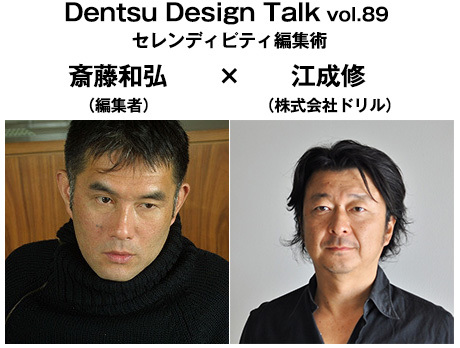Following the first part, we present the second part of the talk session "Serendipity Editing Techniques" featuring Kazuhiro Saito, who has long worked as an editor and is now active as a freelancer, and Osamu Enari of Drill Inc.
(Planning & Production: Dentsu Inc. Human Resources Bureau, Aki Kanahara / Article Editing: Sugatsuke Office / Composition Support: Eiji Kobayashi)

"The only rule is 'to create things that don't exist in the world'"
Mr. Saito also overhauled the editorial structure at BRUTUS, deciding to "give each editor three months per feature to work on it alone." Underpinning this approach was a "doctrine of human goodness" – the belief that "magazine editors naturally want to handle as many pages as possible, and everything from planning to editing" – and the accompanying "responsibility and trust." What was even more groundbreaking was breaking down the barriers between editorial and advertising. "When I became an editor, I was told not to think about advertising. I believe this reflects a certain ethical stance among magazine editors, but I actively embraced advertising. Lifestyle magazines like those produced by Magazine House ultimately treat everything they cover—even editorial pages—as products. In fact, a magazine's entertainment value encompasses both editorial and advertising pages; its appeal lies solely in the uniqueness of the entire publication. My only rule was to create content that didn't exist in the world. So conversely, no matter how much a client wanted something through a tie-up, I wouldn't create it unless I was convinced by my own idea. We charge high fees, but advertising is ultimately editorial too." This strategy succeeded, increasing advertising revenue and establishing a business model generating an annual profit of 500 million yen.
"Sitting front row at Paris Fashion Week—that's serendipity."
Saito's next step was to brand not just the content, but the media itself. "I realized midway that branding made generating profits overwhelmingly easier. To achieve that, I believed we should pursue branding as a business for the entire media entity, not just for specific content." While his concrete plan faced internal resistance, he coincidentally received an offer from a headhunting firm: "Would you like to become President of Condé Nast Japan?" It turned out Condé Nast was pursuing the same business model as Saito: "branding the magazine business to achieve high profitability." He took the helm as president in February 2001. Though he hadn't intended to handle editing at Condé Nast, when he overhauled the personnel at VOGUE JAPAN, he couldn't find an editor-in-chief. Consequently, he ended up taking on the role of editor-in-chief for the fashion magazine, despite having no prior experience. "As a child, I was told I should become a farmer. I never imagined I'd sit front row at Paris Fashion Week. I call this serendipity," said Saito. He launched GQ JAPAN in 2003 and remained at the forefront as an editor until leaving Condé Nast in 2009.
"Method Neutral: Embracing Serendipity to Shape the Final Form"
Building on this discussion, Enari introduced examples of "Method Neutral" advertising campaigns he personally handled. The case of Yurakucho Marui, an experiential campaign built around the key concept of "Fashion Therapy," was "a magazine-like project where we, as editors-in-chief, commissioned and organized interesting creators from around the world—New York, Los Angeles, Germany."
He also highlighted IKEA's debut campaign "4.5MUSEUM," where they created 15 four-and-a-half-tatami-mat spaces along the tree-lined path in front of the National Art Museum in Jingu Gaien. He described it as "planning that spiraled rather than moved in a straight line, where big ideas emerged through various encounters and serendipitous insights." He also introduced actual ads and videos, such as docomo's "Forest Xylophone" project—where, when a presentation-approved idea became budget-prohibitive, he intuitively judged a staff member's suggestion to be good and built a 44-meter xylophone in the forest using thinned timber—and the highly successful tower mansion ad campaign centered on the "Symphonic City" concept, which added the value of music and culture.


"The Essence of Serendipity Editing"
Finally, Saito stated the essence of "Serendipity Editing": what editors and advertising professionals share is that "(leaders) only decide the broad framework and fine details, leaving everything else to talented people," and that "choosing people is also a kind of serendipity." He further declared, "People often say an editor's network is crucial, but that's a complete lie. If the concept is compelling, any talent will gather around it." This persuasive statement, backed by Saito's own illustrious career, concluded the talk session.
※The next Dentsu Design Talk is scheduled for Friday, January 10, 2014.






